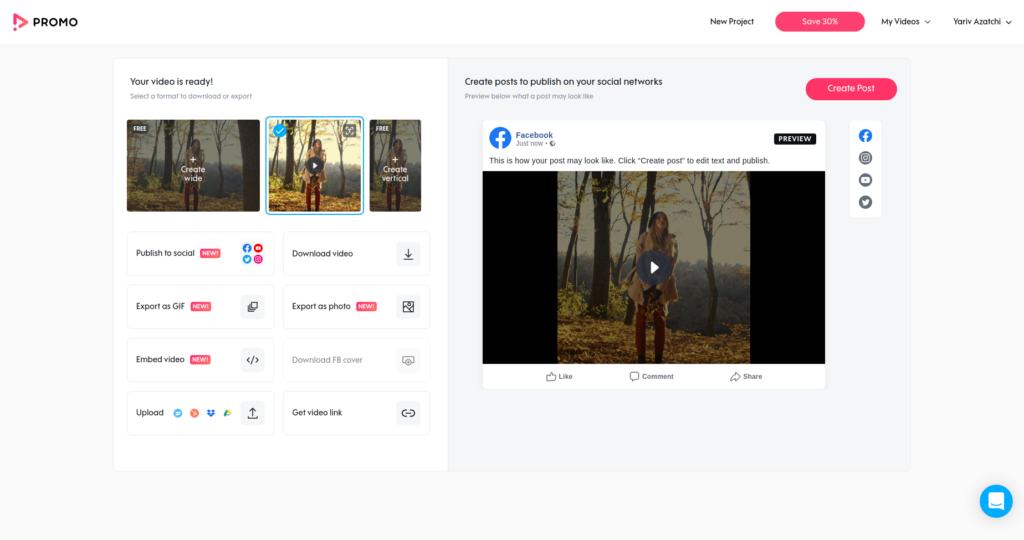
Ask an expert: adapting to challenges

Promo is a leading video creation platform for small and medium-sized businesses. Yariv Azatchi is the chief technology officer at Promo and is the man connecting product and data in the company. In this interview, we discussed the effects of the pandemic on their business, the challenges they’ve faced, and how they’ve adapted to them while keeping value at the core of their operations.
Tell us about the company. When was it founded? Why was it founded?
Promo.com was founded in 2012 as a world-leading online video creation platform and cloud-based video-making service for businesses. Our company enables businesses of all sizes to promote their vision without limits through video content. With 86% of businesses currently using video as a marketing tool, Promo.com helps professionals across the globe reach their audience and market their business at scale. We provide this value through easy video editing tools and exclusive access to millions of premium video clips and images, ready-made templates, pre-edited licensed music, and more. Not only is Promo.com a solution to any video-making need, but it’s also actively changing the way businesses around the world promote, engage and communicate online.
Who is the target audience?
Small and medium-sized businesses have been our primary focus, but as the market matured, there’s been a shift towards bigger companies, and today even Fortune 500 companies are using our tool to promote themselves.
What makes it different from competitors?
There are more than 30 video editing tools in the market. Promo.com differs from competitors with:
- Its ease of use and simplicity. We make it very easy to generate marketing and social media videos, so businesses can promote their brand and expand their online presence as much as they want or need to. We accomplish this by keeping the platform straightforward to use; rather than packing in a ton of features to make trivial stylistic decisions that can be distracting or stressful, Promo’s platform allows users to simply focus on their message.
- A vast library of stock footage with over 110 million assets: Thanks to our partnership with Getty Images, our users have access to high-quality, fully licensed photos and video assets that allow them to create their own professional videos with a minimal cost.
- Unlimited use of premium and editorial content: Promo is the only platform to offer unlimited access and use of editorial footage and premium content. Members of our business plan can power their video projects with footage from the latest real-time events, celebrities, sporting events, news, and more. This gives them a huge advantage in the online space as they can always be part of the trending online conversation.
What’s your role at Promo? What does your day-to-day look like?
I am the CTO, which means I’m sitting at the intersection between technology, product, and data. I combine my technical understanding of the platform with product needs and data. A typical day usually starts in Mixpanel, digging into various reports that monitor our key metrics. I also check the AB tests we have running to see how new features are behaving. I will then meet the product and the data teams to check-in, but my main focus is on creating the future of the company rather than on the day-to-day delivery.
What are the biggest business challenges you’re facing right now?
The pandemic was a huge game-changer for us, moving our business forward at a rapid rate but also introducing new challenges. Tens of thousands of brick-and-mortar businesses simultaneously moved their business online, and with that came a great demand for content solutions and video marketing opportunities – both problems that we aim to solve for our users. Ultimately, that means we’re now trying to balance the spike in demand we experienced with retaining those new users.
As businesses moved from traditional, face-to-face channels to the internet we reaped the benefits with a huge lift in acquisition. For example, while before the pandemic we had very little search volume, we now acquire new users at a higher volume and lower cost. It’s been great for increasing our user base while also lowering marketing costs.
As the market matures and we continue to scale, it’s now also becoming increasingly important for us to figure out how to give more value to the user at a lower cost. We want to provide more beyond just video editing, such as adding publishing capabilities and other features, so scaling in a sustainable way that keeps customer value at its core is of high importance.
Which metrics does your company use to track business health?
These days, we’re very focused on our retention rate. Our company still tracks new user acquisitions, but our success comes from retaining users. Engagement and usage metrics are key indicators for retention so we monitor those closely: for example, KPIs like number of published videos per user and number of users publishing on the platform.
Other metrics we keep an eye on include revenue, annual recurring revenue, retention, etc., broken by geographical and different demographics. As the data grows, we’re also scaling our data teams to get more insights.
How have your ‘metrics that matter’ changed over time?
They’ve changed due to our maturity as a company and platform. In the beginning, Promo was focused on growth, conversions, and making sure the platform was working. But over time we came to understand that we’d reached a turning point where real success needed to come from the retention of users. This was a tough shift because the product has low switching costs so we changed gradually. The first thing we started tracking were published videos per subscriber, but this wasn’t enough. We needed to activate more users. By combining the general engagement rates and engagement per user, we were able to see a better correlation with retention.
How do you communicate these metrics across your organization?
Before Covid we had monitors throughout the office with dashboards displaying run rate vs. goals. At all times everyone was informed on where our performance stood. TV screens were no longer an option post-Covid, so we had to adapt. Now, we send monthly reports to managers, have meetings with teams, and inform about goals and performance via emails and reports.
But what’s really important to us is that everyone can access and explore the data. Everyone in the company has access to Mixpanel, and because it’s so accessible all our teams know how to use it. In fact, around 60% of the teams use it, and 50% need to use it daily.
What’s different about tracking metrics in your industry, and your company specifically, compared to other companies?
We’re a data-driven company with a huge amount of users, so we have to make decisions based on data. While we’ll use questionnaires and interviews with customers from time to time to add more context to the insights we uncover, ultimately we look to data as the driver of decisions in the company.
I think the industry has become increasingly data-driven, but we probably take that further than most. For example, if we launch a new feature, and we eventually understand it’s not measurable, then to us the feature “doesn’t exist” because we won’t know if it works or not. It might sound extreme, but embodying that culture of data is what sets us apart and enables us to continue delivering value to our users.
What are some of the trends you’ve discovered in data that made your company change something?
Our publishing feature, which enables direct publishing to social media channels and several other video export options, is the most significant change; it wasn’t something we’d initially thought of. We found that people using this feature tended to become more engaged than the users who weren’t, so now we’re focusing our efforts on improving that feature. Users come to the platform not only to create a video but to promote their brands, so we have to be able to give this solution to the users.

What’s next for Promo.com?
We’re currently working on adjusting the value-to-cost ratio as a short-term goal. In the long term, we’re working on building marketing capabilities. Our research found that no parameter affects retention more than publishing capabilities, so we’re investing more and more time into developing richer publishing options.
Furthermore, in the upcoming weeks, Promo’s online media library will welcome the exciting addition of millions of editorial photos and videos. This addition will be a game-changer for small businesses that seek creative ways to populate their content calendar and leverage social media marketing opportunities. Soon, businesses creating videos with Promo’s video maker will be able not only to promote their businesses, but also to engage their audience at scale with high-quality editorial footage featuring the most relevant content, talked about celebrities, and news.
The editorial media will be unlimited for users on Promo’s business plan and will allow businesses to grow their online presence, engage better and build more meaningful relationships with their audiences.
Powered by Getty Images and iStock, Promo’s media library is already the largest online media library for businesses creating videos. The recent inclusion of editorial media is only the first step of many exciting developments that will be launched in 2022 on Promo.





